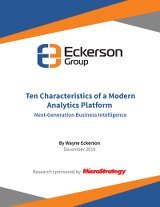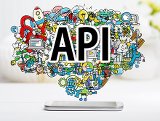
Usability im DMS-Auswahlprozess
 Durch die wachsende digitale Informationsflut in kleinen und mittelständischen Unternehmen (KMU) gewinnt der Bereich der Dokumentenmanagementsysteme (DMS) zunehmend an Bedeutung.
Durch die wachsende digitale Informationsflut in kleinen und mittelständischen Unternehmen (KMU) gewinnt der Bereich der Dokumentenmanagementsysteme (DMS) zunehmend an Bedeutung.

 Durch die wachsende digitale Informationsflut in kleinen und mittelständischen Unternehmen (KMU) gewinnt der Bereich der Dokumentenmanagementsysteme (DMS) zunehmend an Bedeutung.
Durch die wachsende digitale Informationsflut in kleinen und mittelständischen Unternehmen (KMU) gewinnt der Bereich der Dokumentenmanagementsysteme (DMS) zunehmend an Bedeutung.


Dieses Whitepaper beschreibt die 10 herausragenden Merkmale einer modernen Analytik-Plattform. Sie bietet Business-und BI-Managern einen exzellenten Überblick über die Punkte, auf die es in einem neuen oder bestehenden BI- und Analytics-Produkt ankommt.

 Die digitale Vernetzung in den unterschiedlichsten Bereichen der Wirtschaft und des täglichen Lebens wird für die IT zu einer immer größeren Herausforderung. IT-Lösungen werden längst nicht mehr in isolierten Räumen, sondern im stetigen Dialog mit Spezialisten und Anwendern entwickelt.
Die digitale Vernetzung in den unterschiedlichsten Bereichen der Wirtschaft und des täglichen Lebens wird für die IT zu einer immer größeren Herausforderung. IT-Lösungen werden längst nicht mehr in isolierten Räumen, sondern im stetigen Dialog mit Spezialisten und Anwendern entwickelt.

 Die bei Computern weit verbreiteten USB-Verbindungen sind ein potenzielles Sicherheitsrisiko. Denn in vielen Fällen lecken sie Daten, wie Forscher der University of Adelaide gezeigt haben.
Die bei Computern weit verbreiteten USB-Verbindungen sind ein potenzielles Sicherheitsrisiko. Denn in vielen Fällen lecken sie Daten, wie Forscher der University of Adelaide gezeigt haben.
McAfee stellt ab heute für einen befristeten Zeitraum eine kostenlose Testversion der McAfee Virtual Network Security Platform (McAfee vNSP) auf Amazon Web Services (AWS) zur Verfügung.

 App-Entwickler stehen unter einem enormen Druck: Sie müssen innovative Lösungen in immer kürzerer Zeit produzieren, möglichst noch bei geringeren Kosten. Deswegen ist es auch nicht weiter verwunderlich, dass APIs (Application Program Interfaces) immer beliebter werden und mittlerweile zu den Standard-Tools im Entwickler-Repertoire gehören, da sie die Entwicklung erleichtern und den Zeitaufwand deutlich reduzieren.
App-Entwickler stehen unter einem enormen Druck: Sie müssen innovative Lösungen in immer kürzerer Zeit produzieren, möglichst noch bei geringeren Kosten. Deswegen ist es auch nicht weiter verwunderlich, dass APIs (Application Program Interfaces) immer beliebter werden und mittlerweile zu den Standard-Tools im Entwickler-Repertoire gehören, da sie die Entwicklung erleichtern und den Zeitaufwand deutlich reduzieren.

 Anwendungen verändern die Geschäftswelt immer schneller. Daher müssen Unternehmen eine neue Strategie entwickeln, die vor allem DevOps-Methoden, den Zugang zu Mobilität und die Entwicklung von Cloud-Architekturen umfasst. Auf dieser Basis sollen ihre Apps schneller, intelligenter und sicherer laufen.
Anwendungen verändern die Geschäftswelt immer schneller. Daher müssen Unternehmen eine neue Strategie entwickeln, die vor allem DevOps-Methoden, den Zugang zu Mobilität und die Entwicklung von Cloud-Architekturen umfasst. Auf dieser Basis sollen ihre Apps schneller, intelligenter und sicherer laufen.

 Dass Agilität immer mehr Unternehmen erreicht hat und sich verschiedene Frameworks aus der agilen Welt dabei zum Standard entwickelt haben, steht zweifelsohne außer Frage. Ein Artikel allein zu diesem Thema würde wohl kaum mehr einen Aufschrei erzeugen.
Dass Agilität immer mehr Unternehmen erreicht hat und sich verschiedene Frameworks aus der agilen Welt dabei zum Standard entwickelt haben, steht zweifelsohne außer Frage. Ein Artikel allein zu diesem Thema würde wohl kaum mehr einen Aufschrei erzeugen.

 Wie lassen sich orts- und raumbezogene Trends aus Massendaten erkennen, so dass Firmen und Gewerbetreibende ihre strategische Planung lokal und regional optimieren können?
Wie lassen sich orts- und raumbezogene Trends aus Massendaten erkennen, so dass Firmen und Gewerbetreibende ihre strategische Planung lokal und regional optimieren können?
Die EU-Kommission hat ein von VATM-Mitglied DNS:NET ausgestaltetes Vorleistungsprodukt beim Einsatz von Vectoring genehmigt.
Onlineportal von IT Management
We firmly believe that the internet should be available and accessible to anyone, and are committed to providing a website that is accessible to the widest possible audience, regardless of circumstance and ability.
To fulfill this, we aim to adhere as strictly as possible to the World Wide Web Consortium’s (W3C) Web Content Accessibility Guidelines 2.1 (WCAG 2.1) at the AA level. These guidelines explain how to make web content accessible to people with a wide array of disabilities. Complying with those guidelines helps us ensure that the website is accessible to all people: blind people, people with motor impairments, visual impairment, cognitive disabilities, and more.
This website utilizes various technologies that are meant to make it as accessible as possible at all times. We utilize an accessibility interface that allows persons with specific disabilities to adjust the website’s UI (user interface) and design it to their personal needs.
Additionally, the website utilizes an AI-based application that runs in the background and optimizes its accessibility level constantly. This application remediates the website’s HTML, adapts Its functionality and behavior for screen-readers used by the blind users, and for keyboard functions used by individuals with motor impairments.
If you’ve found a malfunction or have ideas for improvement, we’ll be happy to hear from you. You can reach out to the website’s operators by using the following email
Our website implements the ARIA attributes (Accessible Rich Internet Applications) technique, alongside various different behavioral changes, to ensure blind users visiting with screen-readers are able to read, comprehend, and enjoy the website’s functions. As soon as a user with a screen-reader enters your site, they immediately receive a prompt to enter the Screen-Reader Profile so they can browse and operate your site effectively. Here’s how our website covers some of the most important screen-reader requirements, alongside console screenshots of code examples:
Screen-reader optimization: we run a background process that learns the website’s components from top to bottom, to ensure ongoing compliance even when updating the website. In this process, we provide screen-readers with meaningful data using the ARIA set of attributes. For example, we provide accurate form labels; descriptions for actionable icons (social media icons, search icons, cart icons, etc.); validation guidance for form inputs; element roles such as buttons, menus, modal dialogues (popups), and others. Additionally, the background process scans all the website’s images and provides an accurate and meaningful image-object-recognition-based description as an ALT (alternate text) tag for images that are not described. It will also extract texts that are embedded within the image, using an OCR (optical character recognition) technology. To turn on screen-reader adjustments at any time, users need only to press the Alt+1 keyboard combination. Screen-reader users also get automatic announcements to turn the Screen-reader mode on as soon as they enter the website.
These adjustments are compatible with all popular screen readers, including JAWS and NVDA.
Keyboard navigation optimization: The background process also adjusts the website’s HTML, and adds various behaviors using JavaScript code to make the website operable by the keyboard. This includes the ability to navigate the website using the Tab and Shift+Tab keys, operate dropdowns with the arrow keys, close them with Esc, trigger buttons and links using the Enter key, navigate between radio and checkbox elements using the arrow keys, and fill them in with the Spacebar or Enter key.Additionally, keyboard users will find quick-navigation and content-skip menus, available at any time by clicking Alt+1, or as the first elements of the site while navigating with the keyboard. The background process also handles triggered popups by moving the keyboard focus towards them as soon as they appear, and not allow the focus drift outside it.
Users can also use shortcuts such as “M” (menus), “H” (headings), “F” (forms), “B” (buttons), and “G” (graphics) to jump to specific elements.
We aim to support the widest array of browsers and assistive technologies as possible, so our users can choose the best fitting tools for them, with as few limitations as possible. Therefore, we have worked very hard to be able to support all major systems that comprise over 95% of the user market share including Google Chrome, Mozilla Firefox, Apple Safari, Opera and Microsoft Edge, JAWS and NVDA (screen readers).
Despite our very best efforts to allow anybody to adjust the website to their needs. There may still be pages or sections that are not fully accessible, are in the process of becoming accessible, or are lacking an adequate technological solution to make them accessible. Still, we are continually improving our accessibility, adding, updating and improving its options and features, and developing and adopting new technologies. All this is meant to reach the optimal level of accessibility, following technological advancements. For any assistance, please reach out to